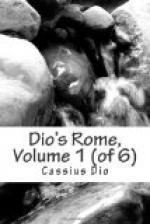Dio has apparently equipped himself extremely well for his undertaking. A fragment edited by Mai (see Fragment I) seems to make him say that he has read every available book upon the subject; and, like Thukydides, he is critical, he is eclectic, and often supports his statements by the citation or introduction of documentary testimony. His superstition is debasing and repellent, but works harm only in limited spheres, and it is counterbalanced by the fact that he had been a part of many events recounted and had held high governmental offices, enjoying a career which furnished him with standards by which to judge the likelihood of allegations regarding earlier periods of Rome,—that, in a word, he was no mere carpet-knight of History. He is honestly conscientious in his use of language, attempting to give the preference to standard phrases and words of classical Greek over corrupt idioms and expressions of a decadent tongue; it is this very conscientiousness, of course, which leads him to adopt so much elaborate syntax from bygone masters of style. Finally,—the point in which, I think, Dio has come nearest to the gloomy Athenian,—something of the matter-of-fact directness of Thukydides is perceptible in this Roman History. The operator unrolls before us the long panorama of wars and plots and bribes and murders: his pictures speak, but he himself seldom interjects a word. Sometimes the lack of comment seems almost brutal, but what need to darken the torture-chamber in the House of Hades?
There are two ways of writing history. One is to observe a strictly chronological order, describing together only such events as took place in a single year or reign; and the other, to give all in one place and in one narration the story of a single great movement, though it should cover several years and a fraction,—or, again, to sketch the condition of affairs in one province, or valley, or peninsula for so long a time as the story of such a region seems to possess unity of development. The first kind of writing takes the year or the reign as its standard, whereas the second uses the matter under discussion or some part of the earth in the same way: and they may accordingly be called, one, the chronological method, and the other, the pragmato-geographical. The difference between the two is well illustrated by the varying ways in which modern works on Greek history treat the affairs of Sicily.
The first plan is that which Dio follows, and his work would have been called by the Romans annales rather than historiae. The method has its advantages, one of which is, or should be, that the reader knows just how far he has progressed; he can compare the relative significance of events happening at the same time in widely separated lands: he is, as it were, living in the past, and receives from week to week or month to month reports of the world’s doings in all quarters. On the other hand, this plan lacks dramatic force; there are




